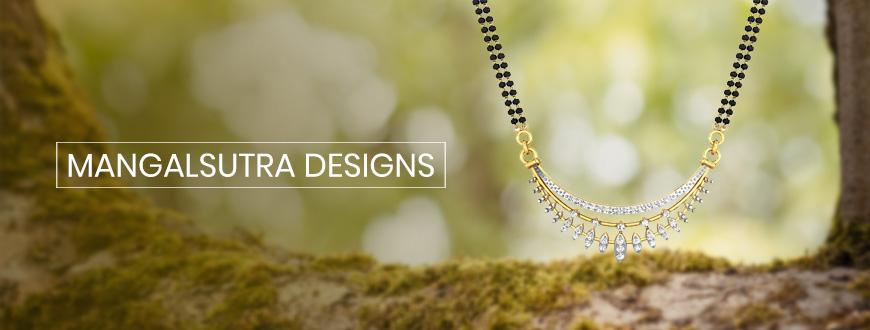Kalyan Wiki

Mangalsutra Designs
Almost all cultures across the globe have one or more symbol for marriage. In India, the diverse cultures, religions and regions have different symbols for marriage. For Kashmiri Pandits, it's a long earring called 'Dejharoo'. Nose rings and toe rings are significant in the Northern states. Bangles or Choora are very significant in some cultures. The Mangalsutra, however, is probably the most important symbol of marriage in India.
It is known by different names in different regions. Maangalyamu, Thali, Thirumangalyam, Minnu, Maangalya Sutra, Pathak, Mangalasutramu, Ramar Thaali, Pustelu, etc. are some of its names in different regions of the country. 'Mangal' means holy or auspicious and 'sutra' means a thread or a cord. Mangalsutra, therefore, signifies the holy bond or union between the husband and wife. It is believed that the concept of tying the Mangalsutra originated in the South and eventually found its way into Northern regions. Many Northern cultures such as Marwaris, Kashmiris, and Sikhs etc. have other ornaments in place of Mangalsutra.
The thread is tied in three knots. The first knot signifies loyalty, the second commitment towards the husband's family and third as a prayer to the almighty God for protection from evil. The mantras recited during the ceremony declares that this holy thread stands for the groom's well being and he hopes that his bride will live a long life with him. Hence a broken mangalsutra is considered inauspicious or a bad omen.
Mangalsutra is one of the most essential components of 'Soubhagya Alankar' which means ornament of a married woman. In Kerala and Tamil Nadu, the Thali are small pieces of gold tied on a thread. In Kerala, the Thali is mostly shaped like a leaf and called 'Ela Thaali'. Christians have a cross engraved on it while Hindus have figures of Gods or Goddesses. Thirumangalyam in Tamil Nadu comes in several different shapes and designs according to different castes and communities. These are usually worn on gold chains after marriage. Mangalsutras in Karnataka, Andhra Pradesh, Maharashtra and several other regions are made of black beads on a gold chain with gold pendants in the middle. Some Telugu communities have coloured coral beads along with black beads. 'Bottu' Mangalsutra has gold coin pendants with engravings while 'Pustelu' Mangalsutra has spherical gold discs. These are similar to the 'Vatis' in a Maharashtrian Mangalsutra.
The gold pendants on a Maharashtrian Mangalsutra are two hollow spherical discs called 'Vatis'. Ideally, they are supposed to be smooth, devoid of any design, so that they can radiate positive energy without any obstruction. The black beads absorb all the negative energy and the gold beads eliminate them. Thus the Mangalsutra is believed to protect the wearer, her marriage and the family from evil. A traditional Mangalsutra has two strings to represent the union of Shiva and Shakti. So, it symbolises the holy union of husband and wife. The black beads represent Shiva, while the gold beads represent Shakti.
The left portion of the ornament attracts and emits 'Ichha-Shakti', the right portion 'Dnyan-Shakti' and the middle part 'Kriya-Shakti'. They work together to help the person attain the 'Nirguna' level .i.e. become one with 'Nirguna God' who is 'pure divine energy' or 'divine consciousness'. The Mangalsutra is supposed to rest near the heart where it awakens the 'Anahat Chakra'. So the chain length should ideally be between 20-30 inches. The void cups or Vatis face the Anahat Chakra, and the waves from the Dhyan Shakti absorb and eliminate the emotions or 'bhav' from the Chakra. It erases ego and makes the person selfless. There are floral designs above the cup that act as a shield to protect the Anahat Chakra and also attract 'Sagun' or good fortune.
In a traditional Mangalsutra, the two strings are divided into seven sections which represent the seven chakras in the body. Each section has nine black beads that represent nine forms of 'Adi-Shakti'. The Mangalsutra is hence more than an ornament.
Mangalsutra has evolved over the years. The traditional gold vatis have been replaced with diamond pendants in attractive designs. Innumerable designs are now available in the market with pendants studded with diamonds, rubies, sapphires, pearls etc. Floral designs are the most popular. The chain length has also been altered to suit the modern outfits. Many prefer a short-length chain that rests on the collarbone and the diamond pendant at the base of the bone. This style works well with western clothing and is fashionable. Some prefer minimalistic pendants instead of elaborate ones. Some prefer Platinum or Silver instead of Gold.
Customised Mangalsutras are thoughtful and personal. It imbibes a lot of love and care.







